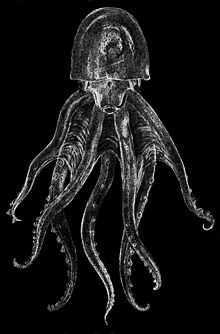Glass octopus
| Glass octopus | |
|---|---|

| |
| Belly view of female | |
| Scientific classification | |
| Domain: | Eukaryota |
| Kingdom: | Animalia |
| Phylum: | Mollusca |
| Class: | Cephalopoda |
| Order: | Octopoda |
| Family: | Amphitretidae |
| Genus: | Vitreledonella Joubin, 1918 |
| Species: | V. richardi |
| Binomial name | |
| Vitreledonella richardi | |
| Synonyms[2] | |
| |
Vitreledonella richardi, also known as the glass octopus, is an incirrate octopus. It is in the genus Vitreledonella and of the family Amphitretidae.
Description
Vitreledonella richardi, also known as the glass octopus, is a transparent, gelatinous, and almost colorless meso- to bathypelagic octopod found worldwide in tropical and subtropical seas. Because this octopus mostly lives in deep ocean waters, there have been very few observations of it in the wild. One of the most recent sightings of the glass octopus occurred in 2021, when marine scientists from Boston University captured video of two glass octopuses while aboard the Falkor research vessel. [3] It has a mantle length up to 11 cm (4.3 in) and a total length up to 45 cm (18 in) in adults. The upper three pairs of arms are subequal in length; in juveniles about as long as the mantle, in adults two to three times mantle length. The fourth, ventral pair is slightly shorter. Suckers are small, widely separated, and in a single series. Male glass octopuses have a hectocotlylized third left arm. This refers to when the male is ready to mate with a female, the arm can detach and release sperm to impregnate the female octopus. The large ampulla and the elongate accessory gland lie out among the internal reproductive organs, notable among mature males alongside its reproductive anatomical counterparts.[4] Seen from the side, its eyes are rectangular. This cylindrical design, with the lens centered, results in a restricted horizontal field of vision, but is thought to be an adaptation that reduces the eye's silhouette when viewed from below as part of the animal's method of camouflage.[5] The radula is heterodont, also known as heteroglossan, in which the middle or rhachidian tooth in each array has multiple cusps and the lateral teeth are unicuspid.
Mating
Vitreledonella richardi is ovoviviparous. The female broods her eggs, of which hundreds are within the mantle cavity. Each egg measures about 4 mm (0.16 in) in length. Newborn larvae have a mantle length around 2.2 mm (0.087 in). The young paralarvae are left to fend for themselves as the mother quickly dies after their birth.[2]
Researchers at Central Marine Fisheries Research Institute conducted an experiment that later concluded young paralarvae beaks change as they get older, along with the depth of water which they want to live in. Younger paralarvae have stronger beaks to tear prey's flesh off since that was all they ate. Once they got older, they lose that beak and form a faint, less developed one to eat softer-bodied prey. With their diet changing, they are predicted to move up from deeper levels (between 310 and 440, but can be as far as 1000 m) to the subsurface (between 110 and 300 m) as they get older.[citation needed]
Ecology
Found mostly in the tropic and subtropic regions of seas worldwide, the glass octopus is prey to the feeding ecology of Northern bottlenose whales. More specifically noted is that of Tåsinge whale.[6]
References
- ^ Allcock, L. (2014). "Vitreledonella richardi". IUCN Red List of Threatened Species. 2014: e.T162988A961420. doi:10.2305/IUCN.UK.2014-3.RLTS.T162988A961420.en. Retrieved 19 November 2021.
- ^ a b c Philippe Bouchet (2013). "Vitreledonella richardi Joubin, 1918". World Register of Marine Species. Flanders Marine Institute. Retrieved 3 February 2018.
- ^ "There's More to the Story behind Rare Glass Octopus Footage". Boston University. 2021-07-22. Retrieved 2024-03-01.
- ^ Voight, J. R. (1996). Male reproductive anatomy of Vitreledonella (Cephalopoda: Octopoda). American Malacological Bulletin, 13(1-2), 61-64.
- ^ Land, M. (1992). A note on the elongated eye of the octopus Vitreledonella richardi. Journal of the Marine Biological Association of the United Kingdom, 72(1), 89–92. doi:10.1017/S0025315400048803
- ^ Santos, M., Pierce, G., Smeenk, C., Addink, M., Kinze, C., Tougaard, S., & Herman, J. (2001). Stomach contents of northern bottlenose whales Hyperoodon ampullatus stranded in the North Sea. Journal of the Marine Biological Association of the United Kingdom, 81(1), 143–150. doi:10.1017/S0025315401003484
- Mcalpine, K. J. (21 July 2021). "There's More to the Story behind Rare Glass Octopus Footage". The Brink. Retrieved 15 April 2023.
- "The Glass Octopus is See-Through and Spectacular". Ocean Conservancy. 15 July 2021. Retrieved 15 April 2023.
- Ulanova, E (June 21, 2018). "Vitreledonella richardi (glass octopus)" (PDF). Academia.
- Sajikumar, K. K., Venkatesan, V., Jeyabaskaran, R., Muhammed, A., & Mohamed, K. S. (2016). First record of the glass octopus Vitreledonella richardi (Cephalopoda: Vitreledonellidae) from the Arabian Sea. Marine Biodiversity Records, 9, 1–4. doi:10.1186/s41200-016-0041-6
External links

